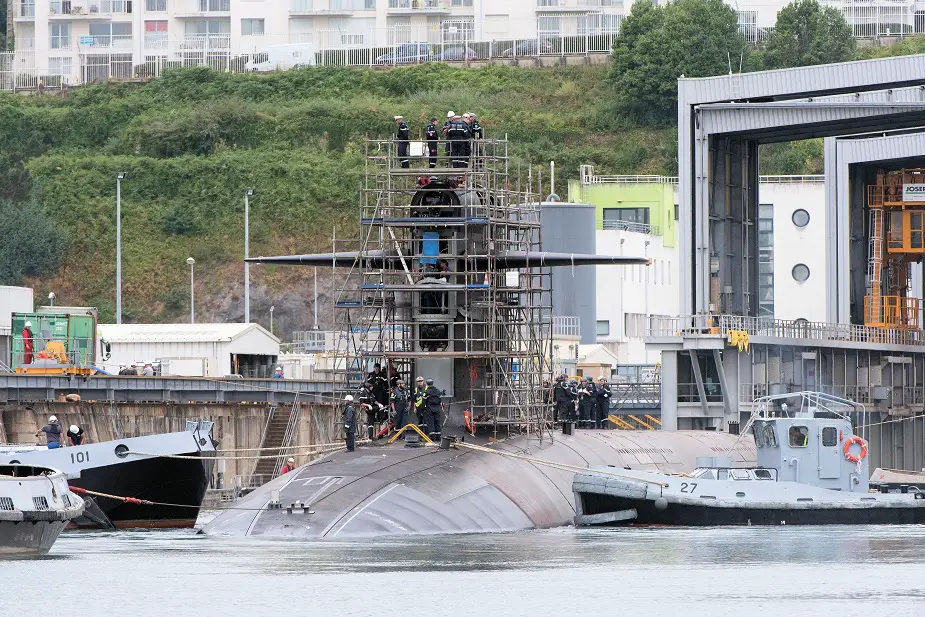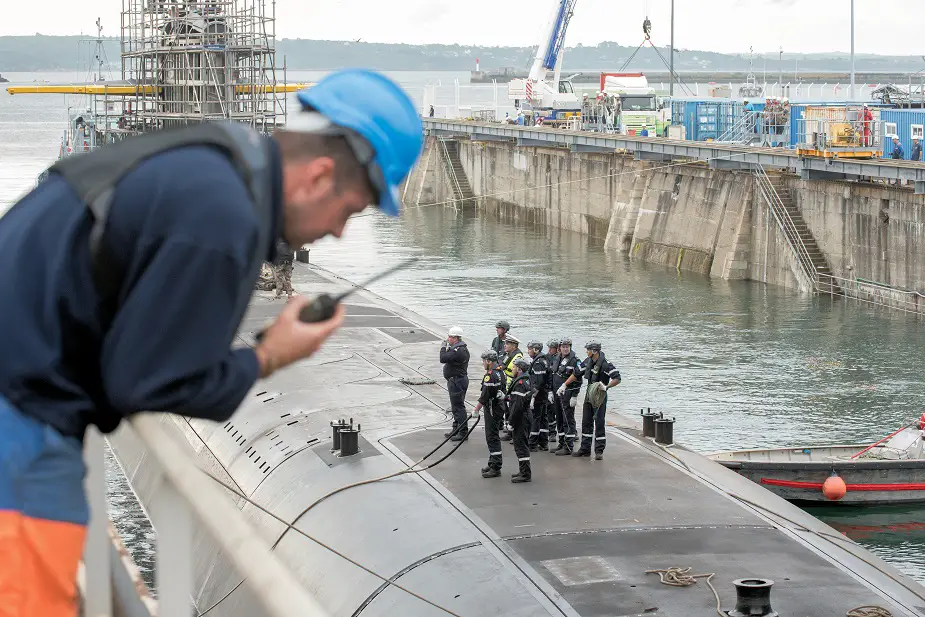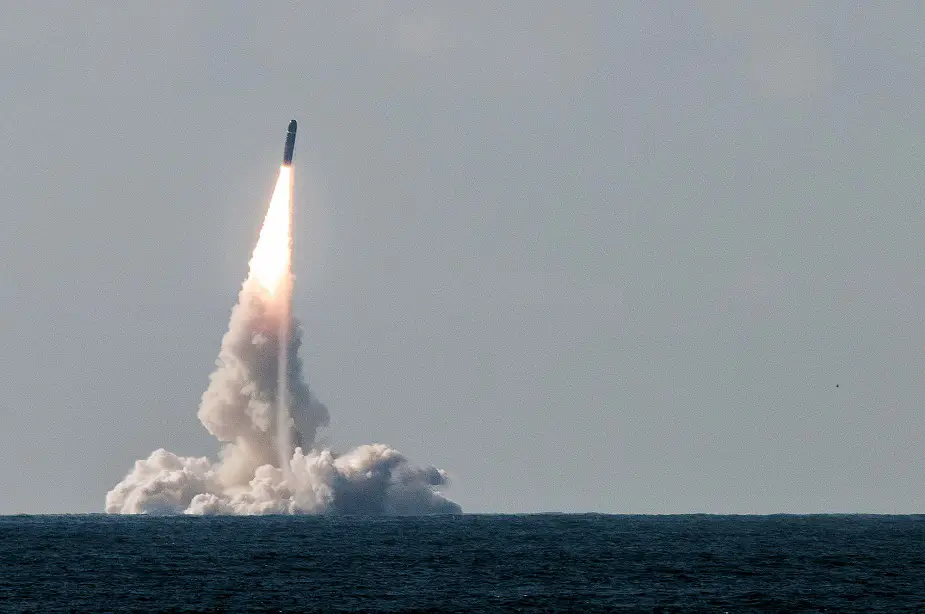Breaking news
Final French Navy SSBN 'Le Temeraire' Upgraded for M51 SLBM.
The French Navy (Marine Nationale) announced that its nuclear-powered ballistic missile submarine (SSBN) Le Téméraire, left a dry dock at Brest naval base on July 20th following 19 months of complex overhaul (called unavailability for maintenance and repairs or IPER). The main objectives of this overhaul was to adapt the submarine to the new generation M51 submarine launched ballistic missile (SLBM) as well as refuel its nuclear reactor.
 French Navy Le Triomphant-class SSBN Le Téméraire taken out of its dry dock in Brest following a complex overhaul. Picture: ©Alain Monot/Marine Nationale/Défense
French Navy Le Triomphant-class SSBN Le Téméraire taken out of its dry dock in Brest following a complex overhaul. Picture: ©Alain Monot/Marine Nationale/Défense
Le Téméraire is the fourth and final Triomphant-class submarine and the last one upgraded to the M51 standard. The in-depth maintenance operation that is coming to an end will give it greater availability for a decade. Its combat and navigation systems were also upgraded to the latest standards during the overhaul. This regular, incremental modernization of SSBNs and their missiles keeps the French Strategic Oceanic Force (FOS) credible and capable.
Le Téméraire still needs to be replenished with nuclear fuel. This will take place at its base in Ile Longue for the last stage of its complex overhaul. The SSBN will then conduct trials at sea and finally receive its new strategic weapons before returning to the operational cycle.
French Navy SSBNs complex overhauls are conducted under joint project management of the DGA (defense procurement agency) and the navy fleet support service. Naval Group acts as prime contractor and whole warship architect. Other entities involved include TechnicAtom (for the nuclear reactor), Airbus Safran Launchers (for the strategic missile), CEA DAM (for the nuclear warheads and simulation).
 French Navy Le Triomphant-class SSBN Le Téméraire taken out of its dry dock in Brest following a complex overhaul. Picture: Jonathan Bellenand/Marine Nationale/Défense
French Navy Le Triomphant-class SSBN Le Téméraire taken out of its dry dock in Brest following a complex overhaul. Picture: Jonathan Bellenand/Marine Nationale/Défense
Le Triomphant-class SSBN
The four Triomphant class ballistic missile submarines of the French Navy entered service in 1997, 1999, 2004, and 2010. These four supersede the older Redoutable class, and they provide the ocean-based component (strategic oceanic force (FOST) Force océanique stratégique) of France's nuclear deterrent strike force.
Le Terrible, last ship of the class which was commissioned in 2010, was fitted with M51 capability from its construction. The other three SSBNs originally deployed M45 missiles and were upgraded for the new M51 missile by DCNS (now Naval Group).
SNLE 3G / FMOD Futur Moyen Oceanique de Dissuasion
As the life of a nuclear submarine is 40 years, the question of the replacement of the Triomphant class is about to arise, for a replacement of the class in the 2030ies. To this end, the French Procurement Agency (DGA) budgeted in 2012 the first studies for the so-called "SNLE 3G" program, the 3rd generation of French SSBNs. These submarines will feature a number of new technologies, inlcuding next generation sonar systems.
 French SLBM M51. French Navy picture.
French SLBM M51. French Navy picture.
M51 SLBM
The M51 is the new generation intercontinental SLBM gradually replacing the M45 since 2010. Each missile carries six to ten independently targetable (MIRV or Multiple Independently targeted Reentry Vehicle) TN 75 thermonuclear warheads. TN 75 are being replaced with the new Tête nucléaire océanique (TNO or oceanic nuclear warhead) warheads since 2015. These new warheads are reported to be maneuverable (MARV or Maneuverable Re-entry Vehicle) in order to avoid potential ballistic defenses. The TNO has a yield that is estimated to be greater than or equal to the yield of the TN 75 warhead, 150 kilotons of TNT (kt) with a CEP (circular error probability) of 150 meters. The warhead's design and functionality were validated through simulation, particularly with DAM's Tera 100 supercomputer, Megajoule laser, and radiographic equipment.
The three-stage engine of the M51 is directly derived from the solid propellant boosters of the Ariane 5 space rocket. Open source data indicates an M51 weight of 52,000 kg, a length of 12.0 m and a diameter of 2.3 m. M51 operational range is reported to be 8,000 to 10,000 km with a speed of Mach 25.
The first test launch of an M51 ballistic missile was successfully carried out at Centre d'essais de lancement de missiles (CELM) in Biscarosse, France, on November 9, 2006. The sixth missile test carried out on May 5, 2013, ended in failure. The latest M51 tests in September 2015, and July 2016 were both successful.
FOST
The French Navy deploys the oceanic deterrence component, referred to as the FOST (Force Océanique STratégique) using SSBNs and transmission centres. It also maintains the nuclear aeronaval force embarked on the Charles de Gaulle aircraft carrier (called FANU), while the French Air Force is responsible for the strategic air forces.
Today, the fleet of 4 SSBNs ensures that 3 can be maintained in the operational cycle and continuously guarantee there is at least one SSBN at sea during peacetime.



























